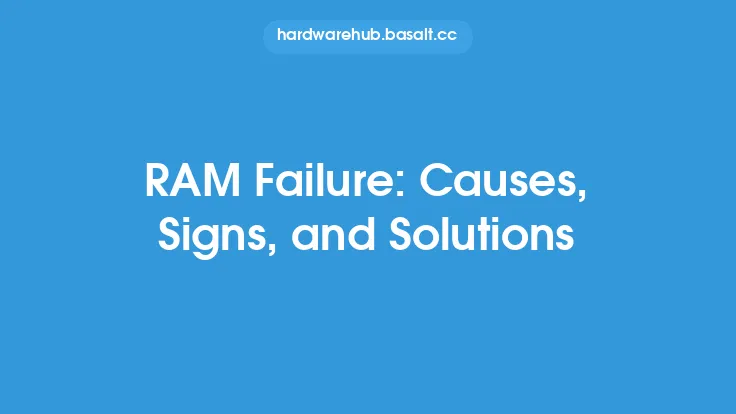When it comes to computer hardware, the motherboard is the main circuit board that connects all the components together, allowing them to communicate and function properly. It is the backbone of the computer system, and its failure can render the entire system useless. Motherboard failure can be caused by a variety of factors, and it is essential to identify the symptoms and causes to take corrective action. In this article, we will delve into the world of motherboard failure, exploring the common symptoms and causes, and providing a comprehensive guide to help you understand and address the issue.
Introduction to Motherboard Failure
Motherboard failure can occur due to various reasons, including physical damage, electrical surges, overheating, and component failure. The failure can be partial or complete, depending on the severity of the issue. Partial failure may cause the system to malfunction or behave erratically, while complete failure can result in the system not booting up at all. It is crucial to identify the symptoms of motherboard failure to take prompt action and prevent further damage to the system.
Common Symptoms of Motherboard Failure
The symptoms of motherboard failure can vary depending on the cause and severity of the issue. Some common symptoms include:
- The system not booting up or failing to power on
- Random shutdowns or restarts
- Error messages or beep codes during boot-up
- Failure to detect or recognize hardware components
- Overheating or excessive heat generation
- Burning smell or visible signs of physical damage
- Data corruption or loss
- System crashes or freezes
- Inability to install or run software applications
These symptoms can be indicative of a motherboard failure, and it is essential to investigate further to determine the cause of the issue.
Causes of Motherboard Failure
Motherboard failure can be caused by a variety of factors, including:
- Physical damage: Drops, bumps, or other forms of physical stress can cause damage to the motherboard, leading to failure.
- Electrical surges: Power surges, spikes, or other forms of electrical stress can damage the motherboard components, causing failure.
- Overheating: Excessive heat generation can cause the motherboard components to fail, leading to system malfunction or shutdown.
- Component failure: Failure of individual components, such as capacitors, resistors, or ICs, can cause the motherboard to malfunction or fail.
- Corrosion or oxidation: Corrosion or oxidation of the motherboard components can cause failure over time.
- Manufacturing defects: Defects in the manufacturing process can cause the motherboard to fail prematurely.
- Age and wear: Motherboards, like all electronic components, can fail over time due to age and wear.
- Inadequate maintenance: Failure to clean and maintain the motherboard can cause dust buildup, corrosion, and other issues that can lead to failure.
Component-Level Failure
Component-level failure refers to the failure of individual components on the motherboard, such as capacitors, resistors, or ICs. These components can fail due to various reasons, including:
- Capacitor failure: Capacitors can fail due to overheating, electrical surges, or manufacturing defects.
- Resistor failure: Resistors can fail due to overheating, electrical surges, or manufacturing defects.
- IC failure: ICs can fail due to overheating, electrical surges, or manufacturing defects.
- Connector failure: Connectors can fail due to wear and tear, corrosion, or manufacturing defects.
Component-level failure can cause the motherboard to malfunction or fail, and it is essential to identify and replace the faulty component to restore system functionality.
Power-Related Failure
Power-related failure refers to the failure of the motherboard's power delivery system, including the power supply, voltage regulators, and power management ICs. These components can fail due to various reasons, including:
- Power supply failure: The power supply can fail due to overheating, electrical surges, or manufacturing defects.
- Voltage regulator failure: Voltage regulators can fail due to overheating, electrical surges, or manufacturing defects.
- Power management IC failure: Power management ICs can fail due to overheating, electrical surges, or manufacturing defects.
Power-related failure can cause the system to malfunction or shut down, and it is essential to identify and replace the faulty component to restore system functionality.
Diagnostic Techniques
Diagnosing motherboard failure requires a combination of technical knowledge, experience, and specialized tools. Some common diagnostic techniques include:
- Visual inspection: Visual inspection of the motherboard can reveal signs of physical damage, corrosion, or component failure.
- Multimeter testing: Multimeter testing can help identify issues with the power delivery system, voltage regulators, and other components.
- Oscilloscope testing: Oscilloscope testing can help identify issues with the motherboard's clock signals, data signals, and other high-speed signals.
- Software diagnostics: Software diagnostics can help identify issues with the motherboard's firmware, drivers, and other software components.
- Replacement and testing: Replacement and testing of individual components can help identify the faulty component and restore system functionality.
Prevention and Maintenance
Preventing motherboard failure requires regular maintenance, proper handling, and adequate protection. Some common prevention and maintenance techniques include:
- Cleaning and dust removal: Regular cleaning and dust removal can help prevent corrosion, overheating, and other issues.
- Thermal management: Proper thermal management can help prevent overheating and reduce the risk of component failure.
- Surge protection: Surge protection can help prevent electrical surges and spikes from damaging the motherboard components.
- Grounding and bonding: Proper grounding and bonding can help prevent electrical shock and reduce the risk of component failure.
- Firmware updates: Regular firmware updates can help prevent issues with the motherboard's firmware and improve system stability.
By following these prevention and maintenance techniques, you can reduce the risk of motherboard failure and ensure optimal system performance and reliability.





